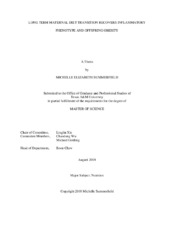| dc.description.abstract | As the obesity epidemic continues to affect the chronic disease status of individuals worldwide, research that aims to elucidate the contribution of maternal health status to the perpetuation of the obesity cycle has become increasingly prevalent. We sought to answer how different time point interventions in maternal diet affect characteristics of obesity and presence of inflammation in the visceral adipose tissue of offspring male mice. Addressing this question, female mice were continued on either a high-fat diet or transitioned from a high-fat diet to a low-fat diet at 1, 5 or 9 weeks prior to pregnancy. Offspring male mice were continued on a HFD for 12 weeks post-weaning. Compared to NF group, the H1N group had significantly increased adipocyte diameter indicative of hypertrophy, while the H5N and H9N offspring had rescued adipocyte hypertrophy although the H5N adipocyte was significantly bigger than the HF offspring. Accordingly, the H1N and H5N offspring increased expression of key adipogenesis and fat trafficking genes compared to the NF group, which was totally reversed in H9N offspring, respectively. F4/80 positive cells indicated decreased number of adipose tissue macrophage in H9N offspring than NF offspring. However, there was increased ATM infiltration in H1N and H5N, compared to the HF offspring. Consistently, the H9N offspring also had the least amount of crown like structures among all groups. Additionally, the H1N offspring had the highest expression of Tnf-α and Il-6 among all groups, while the H9N offspring expressed the similar level as the NF offspring, indicating enhanced adipose tissue inflammation in H1N offspring, which was completely reversed in H9N offspring. This result was echoed by significant upregulation of Jnk and Nf-κB in H1N group, but not H5N or H9N. In conclusion, our study showed that a long-term, but not a short-term transition from HFD to NFD before pregnancy is efficient to block the adipocyte hypertrophy and adipose tissue inflammation induced by maternal HFD. | en |


